Abstract
An experimental campaign of arrays with direct-driven wave energy converters of point-absorbing type is presented. The arrays consist of six identical floats, moving in six degrees of freedom, and six rotating power take-off systems, based on the design developed at Uppsala University. The goals of the work were to study and compare the performances of three different array layouts under several regular and irregular long-crested waves, and in addition, to determine whether the numerical predictions of the best performing array layouts were confirmed by experimental data. The simulations were executed with a frequency domain model restricted to heave, which is a computationally fast approach that was merged into a genetic algorithm optimization routine and used to find optimal array configurations. The results show that good agreement between experiments and simulations is achieved when the test conditions do not induce phenomena of parametric resonance, slack line and wave breaking. Specific non-linear dynamics or extensive sway motion are not captured by the used model, and in such cases the simulation predictions are not accurate, but can nevertheless be used to get an estimate of the power output.
Keywords:
wave energy; arrays; experiments; wave tank; scale test; point absorber; array optimization 1. Introduction
Within ocean waves, an incredibly huge amount of energy is stored which can potentially be extracted and transformed into electricity. An efficient way to produce power in the MW range and to reduce the power fluctuations and the overall costs, is to construct and deploy parks of wave energy converters (WECs). As wave energy technologies are now facing the challenge of early stage commercialization, it is crucial to have access to accurate hydrodynamic and optimization simulation tools for such arrays of converters.
However, analytical and numerical modeling is always connected with some approximations and uncertainties, and physical experiments are required to validate the numerical results. Experiments of wave energy arrays are both expensive and complex to carry out, and it is only in recent years that several large-scale physical experiments have been conducted and their results published [1]. Nevertheless, experimental data are required to validate the numerical models, allowing for an understanding of the levels of uncertainty of the tools commonly used in the design process. In particular, due to the high computational cost, optimization of WEC arrays is typically carried out using simplified models based on assumptions such as restricted degrees of freedom, linear equations that can be solved in the frequency domain, unidirectional waves, etc. There has been little published work comparing these models to the experimental data of arrays and evaluating their validity.
Only a few physical experiments on arrays of point-absorbing WECs have been carried out during the past few years. Konispoliatis and Mavrakos [2] experimentally studied three floating oscillating water column (OWC) devices and compared the results with a semi-analytical multiple scattering method. Experimental results from a three spar-buoy type OWC in scale 1:32 were presented in da Fonseca et al. [3] and compared to the case of an isolated device. The interaction factor in an array of OWC was measured by Magagna et al. [4]. Wolgamot et al. [5] studied trapped modes within an array of eight fixed truncated cylinders, and Ji et al. [6] observed near-trapping in an array of fixed cylinders in short-crested waves. da Fonseca et al. [3] studied a triangular array of three spar-buoy WECs in scale 1:32, and it was observed that the interaction factor was larger than 1 in wave climates with large energy periods. Five fixed OWCs deployed in two different layouts (chosen based on earlier layout optimization) were studied experimentally and numerically by Bosma et al. [7], both in regular and irregular waves: a maximal power increase of 12% was found between the non-optimal and the optimal layout. In Mackay et al. [8], an array consisting of four Wavebob models at scale 1:19 was studied experimentally and compared to a numerical time-domain model. Mercadé Ruiz et al. [9] presented results from numerical simulations and experiments for five WaveStar devices at scale 1:20. Mackay et al. [8] and Mercadé Ruiz et al. [9] studied one array layout, typically a staggered park geometry or WECs in line. On the other hand, Troch et al. [10], Stratigaki et al. [11,12] studied several array layouts with up to 25 heaving point-absorber buoys connected to friction-damping power take-off systems (PTO). In these studies it was found that the wave height was reduced by up to 18% due to park effects. Similarly, Child and Weywada [13] presented results from an analogous experimental set-up with different array layouts of 24 heaving buoys; it was found that the park could experience up to 26% energy loss due to park interactions. Experimental measurements of the responses of an array of five heaving floats in regular waves were compared to numerical predictions in Thomas et al. [14], and in irregular waves by Weller et al. [15]. Nader et al. [16] and Thomas et al. [17] performed array experiments of up to four point-absorber WECs moving in six degrees of freedom. The former experiment, performed at the Australian Maritime College, measured the interaction factor for 1 or 2 floats moving in heave and surge, by tracking the surface elevation with videogrammic measurements. The latter consisted of testing both a linear damping and an advanced control algorithm based on machine learning and artificial neural networks [18]. The energy absorption of three array layouts of WECs with linear damping was compared for six devices in Giassi et al. [19].
Uppsala University (UU) has developed a wave energy converter concept consisting of a buoy and a linear generator (LG) [20]. The buoy transmits the movement of the waves to the translator of the LG on the sea bed and is free to move in six degrees of freedom (DoF). Permanent magnets are mounted on the translator and, during the vertical movement of the translator, electricity is induced in the coils located in the stator, according to Faraday’s law of induction.
This paper presents results from an experimental campaign of wave energy converter arrays. The work was carried out in the COAST Lab at Plymouth University, UK: three different arrays of six devices have been tested under several regular and irregular wave conditions. The model represents a 1:10 scaled prototype of an array of point absorbers, based on the WEC concept developed at Uppsala University. The experimental set-up consisted of six identical ellipsoidal floats free to move in six degrees of freedom and connected via ropes and pulleys to six power take-off systems (PTO) located on a gantry above the water. The PTO was performed by passive damping using a rotatory system appositely designed for the wave tank experiment, described in detail in [21]. To the knowledge of the authors, this experiment represents the first one on point absorbing WEC arrays moving in six degrees of freedom published so far.
The goals of the work are multiple: to provide a set of data for validation of the array model, to study the performances of different array layouts under several wave conditions and to understand whether the genetic algorithm’s optimization tool developed for the specific UU WEC technology [22] can predict optimal layouts in realistic situations. In fact, if the objective function of the optimization is the maximization of the power output, different possible solutions (i.e., array layouts) must be ranked according to their hydrodynamic performance. This experiment intended to clarify whether the predictions of the simulations of the best performing array layouts would be confirmed by experimental data.
In [23] we published the results obtained with a single device in isolation. In [19] the physical set-up was described and some preliminary results in terms of measurements of the wave elevation in the tank and energy absorption for three different array configurations are presented. Here, we present results in terms of array power absorption for different sea states, and for each buoy within the arrays. Through the calculation of the interaction factor (q-factor), the results have been compared to the prediction of the model.
This paper is organized as follows: the numerical model used for the simulation is described in Section 2. Section 3 describes the physical experiments, including the set-up, the array layouts and the tests that were carried out. In Section 4 we describe the parameters used in the array simulations. In Section 5, results of the modeling and experiment are presented and discussed. Further conclusions are drawn in Section 6.
2. Theory and Numerical Model
Mathematical Model
A semi-analytical frequency domain model based on linear potential flow theory and implemented in MATLAB has been used to model the array of converters. We consider a park of WECs labelled by . Each WEC consists of a float, which is a truncated cylinder with individual radius and draft , and the generator is characterized by individual power take-off constants . The model’s equation of motion is restricted to heave motion and unlimited stroke length is assumed. The float and the generator are assumed to be connected by a stiff line, so that one single coupled equation of motion can be written for the float-translator system
where is the total mass of the float and the translator, and are the hydrodynamic excitation and radiation forces, respectively, is the power take-off force and is the hydrostatic restoring force.
By Fourier transformation, the problem can be considered in the frequency domain, in which the equation of motion (1) takes the form
where the radiation force has been divided into added mass () and radiation damping (B) as and and are the frequency domain amplitudes of the excitation force and of the incident waves, respectively. The hydrodynamic forces are computed as surface integrals over the wetted surfaces of the buoys, , where represents the fluid velocity potential that satisfies the Laplace equation in the fluid domain and which is a superposition of incident, scattered and radiated waves, . To evaluate the velocity potential in the fluid domain, a semi-analytical hydrodynamic model based on the multiple scattering method has been used, as previously presented in [24,25].
After computation of the forces, the dynamics of each WEC are determined in the time domain by inverse Fourier transform of the solution to the equation of motion (2), and the instantaneous power absorption computed as
The power output of the park will be the sum of all converters:
The frequency domain model has been coupled with an optimization model based on a genetic algorithm in previous works [22,26]. One of the goals of the present study was to verify the feasibility of optimizing parks of the Uppsala University WEC with such tools. The optimization routine aims to find the best array layout (i.e., set of coordinates of the WECs) which maximizes the power absorption. The genetic algorithm optimization was inspired by Charles Darwin’s theory of evolution and iteratively follows these evolutionary steps: natural selection, pairing, mating or crossover and mutation. Each chromosome in the evolution represents a wave power park, and contains a number of genes equal to the number of WECs in the park. Each gene contains a couple of coordinates for each WEC. The optimization algorithm is described in detail in [22] and it was validated against a parameter sweep optimization for a single WEC, with excellent agreement.
3. Physical Experiments
3.1. Wave Tank
The experimental campaign was carried out in the COAST Lab at the University of Plymouth, UK. The Ocean basin is 35 m long and 15.5 m wide, with a moveable floor set to operate at a depth of 2.5 m. The waves are produced by 24 flap wave makers of 2.0 m hinge depth. At the end of the wave basin a parabolic beach provides energy dissipation and minimizes reflected waves.
A set of ten twin-wire resistance wave gauges have been used to measure the wave elevation at different locations around the basin. To avoid interference with the optical system for motion capture, all the probes are located on the right side of the tank (following the direction of the waves). Their position within the wave tank is shown in Figure 1a (G1 to G10), and was decided in order to enable measurement of the wave elevation at each line of the arrays, and the incoming and outgoing waves. The results of these data have been studied in [19]. On the basin floor floor, connection points for the WECs were installed in a 2 × 2 m grid (Figure 1b).
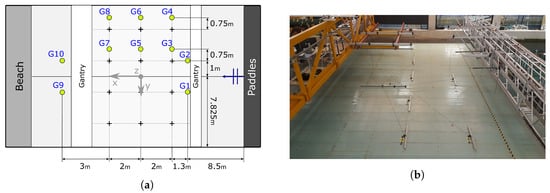
Figure 1.
(a) Schematic top view of the COAST wave basin and location of the the attachment grid (+) with respect to the paddles and the beach. G1–G10 show the locations of the ten wave gauges installed during the experiment. (b) Picture of the attachment bars on the basin floor.
3.2. Experimental Set-Up
The set-up used for this experiment is based on the one introduced in [21,23]. The wave energy converter model tested is a 1:10 scaled prototype based on the point-absorber wave energy concept developed at Uppsala University [20]. In the full-scale device, a buoy is connected via a rope to a linear generator positioned on the sea floor; the motion of the waves induces the motion of the buoy and of the sub-surface generator, inducing electricity in the coils of the stator.
Differently from the work carried out in [23], six devices have been tested simultaneously, forming a park of wave energy converters. Six identical ellipsoidal floating buoys made of polyethylene (0.488 m in diameter and 0.280 m in height; total mass 4378 g) have been used, connected via a system of highly stiff ropes (100% Dyneema, 3 mm) and pulleys (Harken, 57 mm) to the power take-off systems located on the main gantry (Figure 2). Each float was equipped with five reflective markers for motion capture, which were tracked by a set of eight Qualisys six DoF cameras.
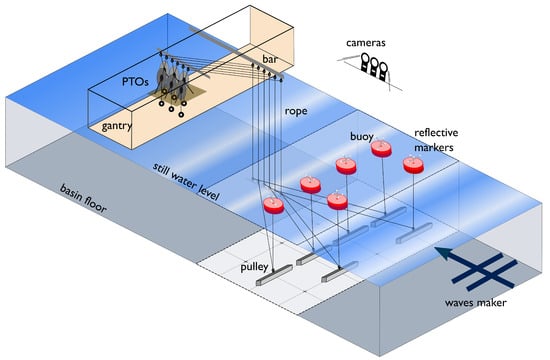
Figure 2.
Sketch of the set-up’s components.
The PTO is a rotatory system consisting of a table securely holding a bicycle truing stand (Tacx T3175) with a bicycle front hub (Shimano XT HB-M756) and a vice (Clarke CSV4E 100mm). On one external side of the bicycle hub, which has a low friction ball bearing, an aluminum disc (2 mm thickness × 40 mm diameter) was mounted, and on the internal part two ropes were wound in opposite directions. One line went towards the upper part through the pulley system to the float; the other line went downwards and held a 5 kg mass. On the vice’s moveable clamps a set of magnets (5 × Neodymium N42 20 × 20 × 10 mm) were positioned. The damping of the PTO was changed by changing the air gap between the magnets and the aluminum disc, which changed the magnetic flux inside the disc. An inertia measurement unit (IMU, Intel Curie SoC) positioned on the disc recorded its rotational speed and accelerations in the disc plane. The experimental power output of each converter was then obtained as
where is the angular velocity of the i- disc and r is the distance between the IMU and the center of the disc. Different damping values were achieved by varying the magnetic flux inside the disc, i.e., by manually changing the distance between the magnets and the aluminum disc. The damping was evaluated by measuring the achieved speed at steady-state with a known mass. In these experiments, a constant damping value of 306 Ns/m for all the converters was used. A more detailed discussion on the PTO and its damping can be found in [21].
3.3. Tests
Table 1 reports the characteristics of the sea states used in the experiment, together with the duration of each test (100 wave periods for regular waves tests and 20 min full scale for irregular wave tests). Waves were long-crested (unidirectional) and propagating along the positive x-axis direction in Figure 1a.

Table 1.
Sea states tested in the wave tank. Top: regular waves, bottom: irregular waves. Scaled values (1:10) (left) and full scale values (right).
Five regular and five irregular sea states were studied for each layout, defined such that they had the same energy per ocean area and energy transport per meter wave crest. The significant wave height was m (scaled value), and the wave (energy) periods spanned the range 1.11–2.37 s. The time series of the irregular waves were obtained from the Bretschneider spectrum.
3.4. Array Layouts
The basin floor was prepared to test three different array layouts, under the ten wave conditions specified in Table 1. All the array configurations were obtained by positioning the floats over a fixed grid of m wide cells, over a total area of 4 × 6 m. The locations of the buoys within the three layouts are shown in Figure 3, Figure 4 and Figure 5, and referred to as array 1 (A1), array 2 (A2) and array 3 (A3), respectively. Each buoy, and corresponding PTO, is identified by a letter (A, B, C, D, E, F).
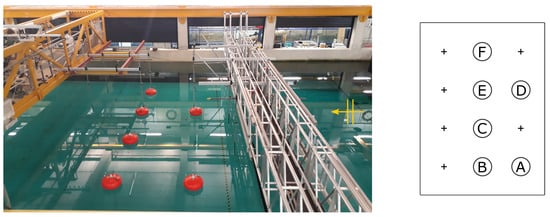
Figure 3.
Layout A1.
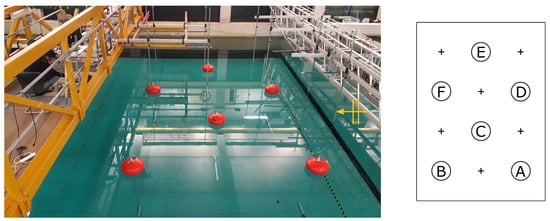
Figure 4.
Layout A2.
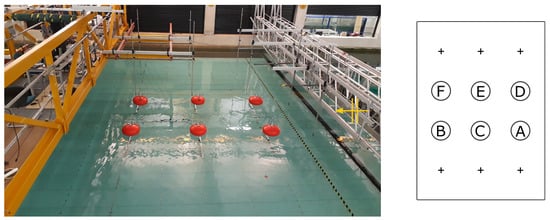
Figure 5.
Layout A3.
A1 consisted of a two-line array with a complete line on the back and a line filled every second spot in the front; A2 consisted of a classical three-line staggered configuration; and A3 was a three-line aligned array. Each array’s upstream line was located 9.8 m from the wave makers. Layout A1 has been tested twice on two different days, while layout A2 and A3 have been tested once.
4. Simulations
As in [23], the float’s geometry has been simulated in two ways: as identical equivalent cylinders of 0.244 m radius and 0.0501 m draft, which correspond to the same submerged volume and radius as the physical elliptical buoy, and as identical equivalent cylinders of 0.178 m radius and 0.0948 m draft, which correspond to the same submerged volume and draft of the physical elliptical buoys. The results corresponding to these two geometries are referred to as frequency domain simulations R1 and R2, respectively. This is due to a restriction of the semi-analytical hydrodynamical model, which can only handle cylinder-shaped floats or cylinders with moon-pool. In the equation of motion an extra rotational inertia of the PTO of 48 kg was added, together with an additional damping of 63.2 Ns/m to account for the friction of the ropes and pulley movement inside the water [21,23].
5. Results and Discussion
In order to analyze the motion data acquired with the Qualisys optical system and understand the results shown in the upcoming section, the authors would like to make the following clarification. Let us consider a cylindrical buoy i moving in three translational degrees of freedom (neglecting the rotational motion for simplicity), (surge, sway and heave, respectively) and the translator moving only vertically, . From the geometry of the problem (Figure 6), the vertical position of the translator is given in terms of the buoy position as
where L is the length of the line connecting the translator and buoy; is the vertical PTO position variation; and the approximation holds up to second order in the small parameter . Here, the case of a slack line is neglected. This approach has been used to estimate the translator position from the float’s motion data.
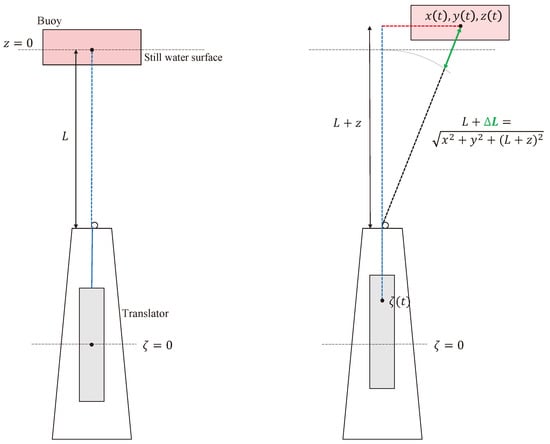
Figure 6.
The wave energy converter (WEC) developed at Uppsala University at equilibrium and with waves, respectively. The translator is situated in a sealed generator hull. The distance L is measured from the top of the generator hull to the water’s surface at equilibrium. In the experimental tests, the distance L was measured from the water’s surface at equilibrium to the pulley on the seabed beneath the buoy. Reproduced from [23].
In the results section the power computed numerically is referred to as , computed from the buoy displacement , which is assumed to be equal to the translator displacement (Equations (3) and (4)). From the experimental results, we display the power absorption measured from the power take-off system (Equation (5)) and the power absorption computed from the buoy motion , computed analogously to Equation (3) where z is replaced with . In other words, is calculated considering all the three translational DoFs of the floats. This latter is called virtual power of the buoy, as it does not represent the actual motion of the PTO, from which power is absorbed. In fact, the buoy motion along the connection line would correspond to the position of the translator only assuming a stiff connection between them, which is assumed in the numerical model, but is not realistic in the physical experiment.
5.1. Power Output
Figure 7 shows the results in terms of average power output over the time window tested, including both experimental and simulation results, for all the three layouts. Simulations are shown for the two buoy geometries mentioned in Section 4.
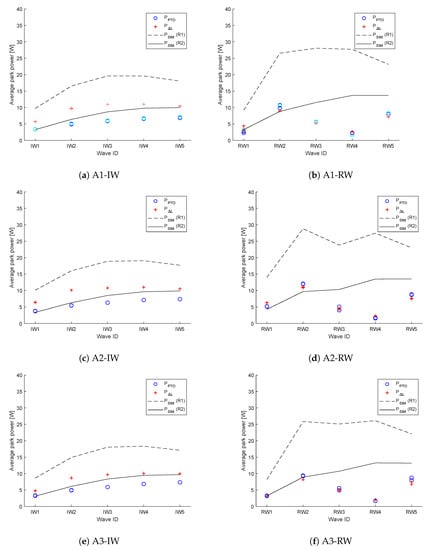
Figure 7.
Average power absorbed by the park. (a,b) Layout A1. (c,d) Layout A2. (e,f) Layout A3. Results from irregular waves are shown in (a,c,e) and regular waves in (b,d,f).
In irregular waves (Figure 7a,c,e), the simulations reproduced the power behavior quite well, even though the error between simulations and experiments increased with increasing energy period. In the case of float geometry R1 the power was overestimated, while in the case of R2 the one-DoF-restricted, simplified simulation fit the experimental data quite well. Within the goals of the present work, it was important to reproduce the qualitative behavior of the power output; i.e., the results obtained with R1 are still useful if the goal is the park optimization by relative comparison between layouts.
The wave height is constant for all wave conditions and the (energy) period increases linearly. The energy flux incident on the buoy thus increases linearly with the wave conditions. As can be seen from Figure 7, the absorbed power increases with the period, but not linearly. The increase is largest for the lowest periods, after which the increase is only small. This can be explained from the fact that the natural period is s, i.e., it lies just below wave condition 2. Hence, the WECs will absorb most power relative to the incident energy in the wave conditions with period around wave condition 2.
From the experimental data, it can be observed that the power computed from the power take-off system () differs from the power computed from the optical system of the float (). This means that the connection line does not behave as a stiff connection, as is the case here. In fact, the intermittent nature of the irregular waves make the float be exposed to sudden and quick changes of its motion, which is not synchronously followed by the rotating PTO, due also to the pulley system and PTO inner inertia. This does not happen in the regular waves, where the motion of the PTO follows the motion of the buoy more easily, at least for the PTO damping used. As we showed in [23], for other damping values, the buoy and PTO motion could differ also in regular waves.
However, in the regular wave results, the experimentally obtained power undergoes a significant reduction in RW3 and RW4, while a lesser reduction is observed in RW5. This can be explained by referring to the results obtained in [23]; a single WEC in isolation was studied in terms of the Mathieu-type instability. Results have shown that in RW3 and RW4 the buoy is affected by a high transverse instability, due to the coupling between heave and sway, resulting in a high sway motion. RW5 displayed only little sway instability. As for the irregular waves, the simulations with geometry R1 overestimated the power (including stable waves); however, in this case we did not expect agreement between the heave model and the experiments that displayed Mathieu instabilities.
An example of results of the buoys’ power output within array A1 is shown in Figure 8, while for array A2 and A3 the data are reported in the Appendices (Figure A1 and Figure A2). The power output of the buoys within the same layout is strongly dependent on the wave condition (regular, irregular) and the wave period. In the regular tests the maximum power is achieved by different buoys according to the wave period; in irregular waves the relative level of power output is more or less kept even over different waves periods; an example for layout A2 is shown in Figure 9. As noted before, the two-body dynamics of the UU WEC are noticeable, especially in irregular waves, from the difference between and measured for each buoy.
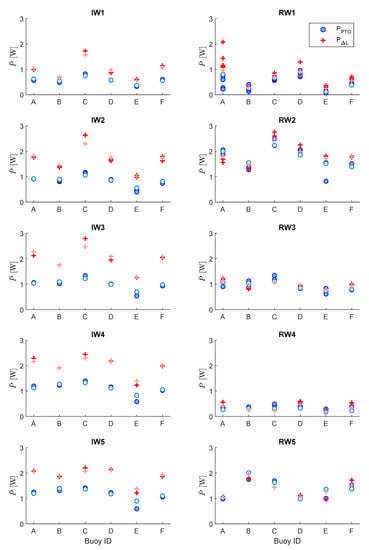
Figure 8.
Average power of each buoy for layout A1 in all the tested sea states. Comparison between obtained from the Qualisys data (+) and obtained from the PTO data (o). Multiple markers refer to repeated tests. Light blue and light red markers refer to layout A1 tested for the second time. The left column shows results in irregular waves, the right column shows results in regular waves.

Figure 9.
Average power output () of the buoys in layout A2. (a) irregular waves; (b) regular waves.
The experimental testing of layout A1 performed at two different occasions has shown consistent results (Figure 7a,b and Figure 8).
Layouts A1 and A2 are not symmetric with respect to the center of the tank, whereas A3 is symmetric with respect to the center of the tank and the lateral walls. However, due to disturbances in the wave tank and high sway motion, there was no symmetry in the experimental results (Figure 8, Figure A1 and Figure A2). The buoys moved in heave, surge and sway in the experiment (if we neglect rotations), and therefore the shadowing effect was minimized. We can notice that on several occasions, the WECs that should have been shadowed produced higher power output than the non-shadowed ones.
5.2. q-Factor
Different layouts have been compared in terms of the interaction factor (or q-factor), defined as:
P represents the total power of the array and is the number of WECs in the park. is the power of the device in isolation, obtained from the previous work for the isolated system in [23]. The experimental q-factor has been compared to the simulated one in Figure 10, for the three layouts. The q-factor values of the WECs within the three layouts are reported in the Appendices (Figure A3, Figure A4 and Figure A5).
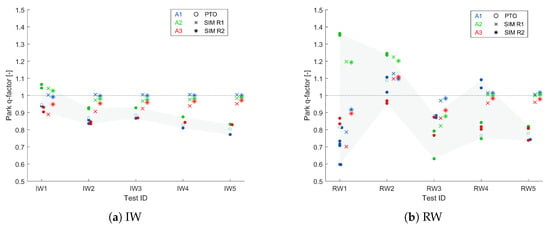
Figure 10.
Comparison of the park q-factor values of layouts A1, A2 and A3, in all the tested sea states, calculated from PTO experimental data (o), from simulations with R1 (x) and from simulations with R2 (*). (a) Irregular waves; (b) regular waves.
The experimental results of Figure 10 show that the best layout was A2 for all the irregular wave conditions and for regular wave conditions RW1, RW2 and RW5. In RW3 and RW4 the best layout was A1.
The best performing layout according to the simulations was A2 in IW1, RW1, RW2 and A1 in IW2, IW3, IW4, IW5, RW3, RW4 and RW5; however, the difference between A1 and A2 was very small.
The shadowed layout, i.e., A3, should have been the worst performing layout for all the wave conditions according to the simulations, but this was not always the case in the experiment. This could be explained by the fact that the experimental WECs were moving in sway, interfering with the expected hydrodynamical interaction and the shadowing effects. In fact, rear devices did experience complete shadowing in the simulations, but not in the wave tank experiment. On the other hand, in the simulations, perfectly heaving devices influenced the hydrodynamic interaction in a different way.
For realistic optimization, we should take into account WECs with at least three DoFs, or better, six DoFs, and waves coming from different directions (multi-directional waves), which would lead to less influence in the shadowing of WECs during the simulations.
The experimental conditions are more controlled in IW1 and IW2, where waves are less energetic and we have less phenomena of slack line and breaking. In these cases we see better agreement of the arrays’ q-factor values with the experimental results. The same is valid for RW1 and RW2, in which the devices do not present parametric resonance. However, there is still some ambiguity between the simulations performed with R1 vs R2.
Both in experiments and simulations, the difference between the arrays in terms of q-factor is small in most of the cases, in particular for all the irregular waves. When we have non-linear dynamics, the discussed uncertainties in the experimental data imply that the modeling is not so accurate as to capture such small variations among layouts. Nevertheless, although the WEC dynamics and the hydrodynamic model is limited by constrained heave motion, the stiff connection between buoys and PTOs and linear dynamics, the q-factor estimation is rather good, and the results are close to the experimental region (gray zone in Figure 10).
In general, we expect the hydrodynamic interaction to be larger in larger parks (i.e., parks with more units) [24], resulting in a larger difference between best and worst layouts. In such cases, the model can be expected to better capture such discrepancies. The present study was based on a trade-off between a feasible experimental campaign and simulation work. A larger layout would have given more accurate information, but would also have been difficult to test.
It is worth mentioning that the sources of uncertainty in an experimental campaign were multiple: reflection of waves against the walls of the tank, possibly unbalanced buoys due to the optical markers, uncertainty in the damping and friction estimation, varying damping due to unbalanced discs, elasticity of the connection line and friction in the pulley system. Whereas the optical markers are not expected to influence the dynamics to a relevant degree, the other uncertainties might affect the results. In [21], the friction and line elasticity for the system were evaluated, and it was found that adding a slight elasticity better reproduced the experimental results, and the friction was measured qualitatively. In this paper, friction has been included in the simulations as an additional damping term. Other potential error sources in wave tank testing, highlighted in [27], are: the spatial variation of the wave-field within the wave basin; the temporal variation of the wave-field from one repeat to another; the repeatability of a model’s response for any single individual WEC; the reproducibility of a model’s response for various identical WECs. In [19] the spatial variation of the wave field around the basin was studied and the results showed that, in irregular waves, the expected significant wave height was always under-reproduced. Moreover, it was found that the discrepancies are larger in relation to shorter periods. To partially asses these problems, repeated tests were executed, when possible, and measurements of the wave field in the empty tank were conducted and used as inputs series in the simulations for the irregular waves. The results from the repeated tests show good agreement, which increases the trustworthiness of the results.
6. Conclusions
The work presented an experimental campaign conducted with six point-absorber WECs moving in six DoFs. The goals were to (a) study the performances of different array layouts under several wave conditions and to (b) understand whether the simulation optimization predictions of best performing array layouts would be confirmed by experimental data. The experimental campaign represents a unique example of array testing with a point-absorber moving in six degrees of freedom. The simulations have been carried out by a frequency domain model restricted to heave, with unlimited stroke length and stiff connection between the float and the generator, so that each WEC is considered as a single body.
6.1. Performances of Different Array Layouts under Several Wave Conditions
Although there is a vast literature on numerical simulations on wave energy parks, there is very little published material on experimental data. The paper is the first publication of experimental data of several array layouts of WECs moving in six DoFs, subjected to both regular and irregular waves.
In both the simulations and the experimental data, arrays A1 and A2 were the best performing layouts in most wave conditions. However, although the numerical simulations predicted that the array A3 should be the worst performing layout in all wave conditions due to the shadowing effect, in the experiments this did not always happen. This can be understood from the fact that in reality, the floats moved also in sway, reducing the shadowing effect. It is worth mentioning that the differences between the best and worst layouts were quite small in irregular waves, both in the simulations and experiments (within 14% in the experiments and within 15.5% and 8% in simulations with R1 and R2, respectively). For larger parks, the shadowing effect would be larger and be present also in realistic conditions, and we would expect both a bigger difference between the layouts and a closer agreement between the simulations and the experimental results. In addition, short-crested waves can decrease the shadowing effect, and thus experiments and simulations using short-crested waves would probably agree to a larger extent.
The power absorption of the array in irregular waves increases with increased energy flux up to an optimum energy period, after which the power is constant or decreases slightly. This behavior is shown both in the simulations and experimental data. Since the natural period of the device is s, i.e., it lies between just below wave condition 2, the WECs will absorb most power relative to the incident energy in the wave conditions with a period around wave condition 2.
The highest q-factor was obtained for the staggered array A2 in the irregular waves with the shortest energy period, in both the experiments (, ) and simulations (). In the simulations, the q-factor was close to 1 in all irregular sea states, whereas it decreased with increasing energy period in the experiments, down to a minimum of . In the regular waves, the range of the q-factor obtained in different wave conditions and for different arrays was much larger, both in the simulations and experiments. Additionally, in the regular waves, the highest q-factor was obtained for the staggered array A2 in the waves with the shortest energy period, both in the simulations and in the experiments.
6.2. Comparison of Simulation Optimization Predictions with Experimental Data
The paper gives several important insights into common assumptions and models used for wave energy park optimization. In most of the modeling works of wave energy parks, in particular in array optimization studies, a stiff connection between the float and the PTO is assumed, and the numerical model of the float is restricted to heave, although the physical float is free to move in six DoFs. Do these two assumptions hold in realistic conditions?
- The experimental data show that in regular waves and for the PTO damping used, the power obtained from the float and the PTO motion is the same, so the assumption of a stiff line is valid. In the irregular waves, however, the WEC shows clear two-body dynamics with different displacement of the float and the PTO due to slack and elasticity in the connection line. As a result, the power obtained from the float and the PTO can differ significantly, and the assumption no longer holds. The virtual power obtained from the float’s motion is in this case higher than the actual power obtained from the PTO; in other words, if a stiff connection between the float and the PTO were to be assumed, the predicted power would be higher than the one that will be obtained in reality. This is confirmed by comparing the power computed in the simulations (which assume a stiff line) with the experimental data: the simulations generally overestimate the absorbed power by the PTO. This conclusion holds both for the total power of the park (Figure 7) and for the power absorbed by the individual buoys (Figure 8).
- The results from the simple one-DoF simulation model are able to reproduce the qualitative behavior of the absorbed power at least to an approximate degree (Figure 7 and Figure 10), as long as non-linear dynamics such as Mathieu instabilities are not present. In the experiments, Mathieu instabilities mostly occurred in some of the regular wave cases; hence, in realistic, irregular waves, the simulations can give an estimation of the power output of the UU WEC. In summary, in the wave conditions wherein we neither observe extensive sway nor non-linear behavior, the results of the optimization are reliable. However, when non-linear dynamics or motions in multiple degrees of freedom are present, then the optimization routine does not provide accurate results. In other words, the discrepancy between the experimental and numerical results is mostly due to either slack line condition (mostly in irregular waves) or Mathieu-type instability (mostly in regular waves). In addition, losses, friction and reflections in the wave tank, and other sources of uncertainty in the experimental set-up, also play roles in the outcome of the present study.
In order to improve the output of the presented model, an array hydrodynamical model with six DoFs and multi-directional waves could be implemented in the optimization routine. To capture the non-linear effects and two-body dynamics, a non-linear time-domain model would be required. However, the computational costs of such a model would probably be too high to enable large-scale optimization.
Author Contributions
Conceptualization, M.G. (Marianna Giassi), J.E., J.I. and M.G. (Malin Göteman); data curation, M.G. (Marianna Giassi); formal analysis, M.G. (Marianna Giassi); funding acquisition, J.E., J.I. and M.G. (Malin Göteman); investigation, M.G. (Marianna Giassi) and M.G. (Malin Göteman); project administration, J.E., J.I. and M.G. (Malin Göteman); supervision, J.E. and M.G. (Malin Göteman); writing—original draft, M.G. (Marianna Giassi); writing—review and editing, J.E., J.I. and M.G. (Malin Göteman). All authors have read and agreed to the published version of the manuscript.
Funding
This research is supported by the the Swedish Research Council (VR, grant number 2015-04657), the Swedish Energy Agency (project number 40421-1), StandUp for Energy, the Lundström-Åman foundation and Miljöfonden.
Acknowledgments
The authors would like to thank Martyn Hann and Edward Ransley for discussions and input provided; and Kieran Monk and Tom Tosdevin for the technical support and help in the COAST Lab ocean basin.
Conflicts of Interest
The authors declare no conflict of interest.
Nomenclature
| Numerical model: | |
| buoy position in surge | |
| buoy position in sway | |
| buoy position in heave | |
| PTO position | |
| PTO damping | |
| WEC power output (ith WEC) | |
| park power output | |
| Experimental data: | |
| buoy position in surge measured by the optical system | |
| buoy position in sway measured by the optical system | |
| buoy position in heave measured by the optical system | |
| buoy position along the connection line calculated from the optical measurements | |
| PTO damping | |
| WEC experimental PTO power output | |
| park experimental PTO power output | |
| WEC experimental virtual power output computed from the buoy motion along the connection line | |
| park experimental virtual power output computed from the buoy motion along the connection line | |
Abbreviations
The following abbreviations are used in this manuscript:
| DoF | Degrees of freedom |
| IW | Irregular wave |
| LG | Linear generator |
| PTO | Power take-off |
| RW | Regular wave |
| UU | Uppsala University |
| WEC | Wave energy converter |
Appendix A
Appendix A.1. WEC’s Power Output
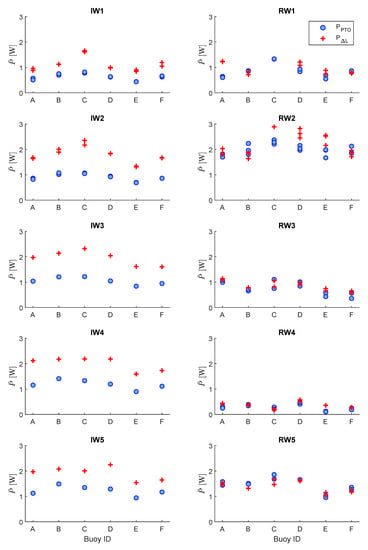
Figure A1.
Average power of each buoy for Layout A2 in all the tested sea states. Comparison between obtained from the Qualisys data (+) and obtained from the PTO data (o). Multiple markers refer to repeated tests. Left column shows results in irregular waves, right column in regular waves.
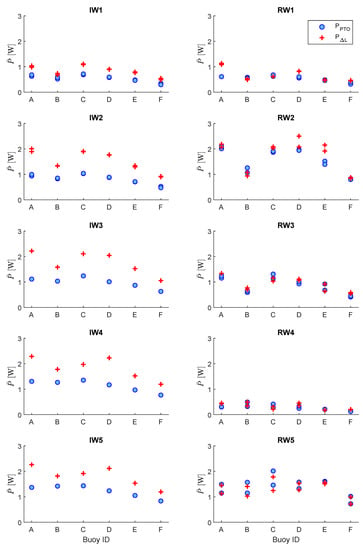
Figure A2.
Average power of each buoy for Layout A3 in all the tested sea states. Comparison between obtained from the Qualisys data (+) and obtained from the PTO data (o). Multiple markers refer to repeated tests. Left column shows results in irregular waves, right column in regular waves.
Appendix A.2. WEC’s q-Factor

Figure A3.
The buoys’ q-factor for layout A1 computed from PTO experimental data and simulations. Left column shows results in irregular waves, right column in regular waves.
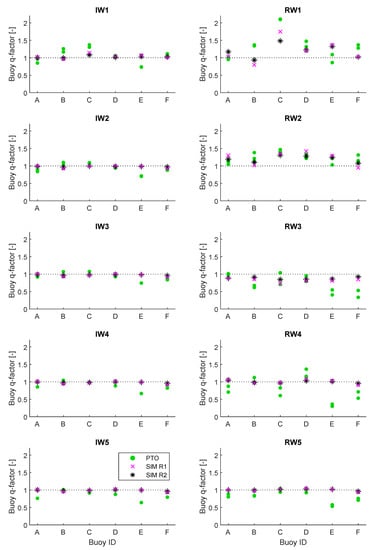
Figure A4.
The buoys’ q-factor for layout A2 computed from PTO experimental data and simulations. Left column shows results in irregular waves, right column in regular waves.

Figure A5.
The buoys’ q-factor for layout A3 computed from PTO experimental data and simulations. Left column shows results in irregular waves, right column in regular waves.
References
- Göteman, M.; Giassi, M.; Engström, J.; Isberg, J. Advances and Challenges in Wave Energy Park Optimization—A Review. Front. Energy Res. 2020, 8, 26. [Google Scholar] [CrossRef]
- Konispoliatis, D.; Mavrakos, S. Mean drift loads on arrays of free floating OWC devices consisting of concentric cylinders. In Proceedings of the 29th International Workshop on Water Waves and Floating Bodies (IWWWFB2014), Osaka, Japan, 30 March–2 April 2014. [Google Scholar]
- Da Fonseca, F.; Gomes, R.; Henriques, J.; Gato, L.; Falcao, A. Model testing of an oscillating water column spar-buoy wave energy converter isolated and in array: Motions and mooring forces. Energy 2016, 112, 1207–1218. [Google Scholar] [CrossRef]
- Magagna, D.; Carr, D.; Stagonas, D.; Mcnabola, A.; Gill, L.; Muller, G. Experimental Evaluation of the Performances of an Array of Multiple Oscillating Water Columns. In Proceedings of the 9th European Wave and Tidal Energy Conference (EWTEC), Southampton, UK, 5–9 September 2011. [Google Scholar]
- Wolgamot, H.; Taylor, P.; Eatock Taylor, R.; Van Den Bremer, T.; Raby, A.; Whittaker, C. Experimental observation of a near-motion-trapped mode: Free motion in heave with negligible radiation. J. Fluid Mech. 2016, 786. [Google Scholar] [CrossRef]
- Ji, X.; Liu, S.; Bingham, H.; Li, J. Multi-directional random wave interaction with an array of cylinders. Ocean. Eng. 2015, 110, 62–77. [Google Scholar] [CrossRef]
- Bosma, B.; Brekken, T.; Lomonaco, P.; DuPont, B.; Sharp, C.; Batten, B. Array modeling and testing of fixed OWC type Wave Energy Converters. In Proceedings of the 13th European Wave and Tidal Conference (EWTEC), Napoli, Italy, 1–6 September 2019. [Google Scholar]
- Mackay, E.; Cruz, J.; Livingstone, M.; Arnold, P. Validation of a Time-Domain Modelling Tool for Wave Energy Converter Arrays. In Proceedings of the 10th European Wave and Tidal Energy Conference, Alborg, Denmark, 2–5 September 2013. [Google Scholar]
- Mercadé Ruiz, P.; Ferri, F.; Kofoed, J. Experimental validation of a wave energy converter array hydrodynamics tool. Sustainability 2017, 9, 115. [Google Scholar] [CrossRef]
- Troch, P.; Stratigaki, V.; Stallard, T.; Forehand, D.; Folley, M.; Kofoed, J.; Benoit, M.; Babarit, A.; Sánchez, D.; De Bosscher, L.; et al. Physical modelling of an array of 25 heaving wave energy converters to quantify variation of response and wave conditions. In Proceedings of the 10th European Wave and Tidal Energy Conference Series (EWTEC), Aalborg, Denmark, 2–5 September 2013; pp. 2–5. [Google Scholar]
- Stratigaki, V.; Troch, P.; Stallard, T.; Forehand, D.; Kofoed, J.; Folley, M.; Benoit, M.; Babarit, A.; Kirkegaard, J. Wave basin experiments with large wave energy converter arrays to study interactions between the converters and effects on other users in the sea and the coastal area. Energies 2014, 7, 701–734. [Google Scholar] [CrossRef]
- Stratigaki, V.; Troch, P.; Stallard, T.; Forehand, D.; Folley, M.; Kofoed, J.; Benoit, M.; Babarit, A.; Vantorre, M.; Kirkegaard, J. Sea-state modification and heaving float interaction factors from physical modelling of arrays of wave energy converters. J. Renew. Sustain. Energy 2015, 7, 061705. [Google Scholar] [CrossRef]
- Child, B.; Weywada, P. Verification and validation of a wave farm planning tool. In Proceedings of the 10th European Wave and Tidal Energy Conference (EWTEC) conference, Aalborg, Denmark, 2–5 September 2013; pp. 2–5. [Google Scholar]
- Thomas, S.; Weller, S.; Stallard, T. Float response within an array: Numerical and experimental comparison. In Proceedings of the 2nd International Conference on Ocean Energy (ICOE), Brest, France, 15–17 October 2008; Volume 1517. [Google Scholar]
- Weller, S.; Stallard, T.; Stansby, P. Interaction factors for a rectangular array of heaving floats in irregular waves. IET Renew. Power Gener. 2010, 4, 628–637. [Google Scholar] [CrossRef]
- Nader, J.; Fleming, A.; Macfarlane, G.; Penesis, I.; Manasseh, R. Novel experimental modelling of the hydrodynamic interactions of arrays of wave energy converters. Int. J. Mar. Energy 2017, 20, 109–124. [Google Scholar] [CrossRef]
- Thomas, S.; Eriksson, M.; Göteman, M.; Hann, M.; Isberg, J.; Engström, J. Experimental and numerical collaborative latching control of wave energy converter arrays. Energies 2018, 11, 3036. [Google Scholar] [CrossRef]
- Thomas, S.; Giassi, M.; Eriksson, M.; Göteman, M.; Isberg, J.; Ransley, E.; Hann, M.; Engström, J. A model free control based on machine learning for energy converters in an array. Big Data Cogn. Comput. 2018, 2, 36. [Google Scholar] [CrossRef]
- Giassi, M.; Thomas, S.; Shahroozi, Z.; Engström, J.; Isberg, J.; Tosdevin, T.; Hann, M.; Göteman, M. Preliminary results from a scaled test of arrays of point-absorbers with 6 DOF. In Proceedings of the 13th European Wave and Tidal Conference (EWTEC), Napoli, Italy, 1–6 September 2019. [Google Scholar]
- Leijon, M.; Waters, R.; Rahm, M.; Svensson, O.; Boström, C.; Strömstedt, E.; Engström, J.; Tyrberg, S.; Savin, A.; Gravråkmo, H.; et al. Catch the wave to electricity. IEEE Power Energy Mag. 2009, 7, 50–54. [Google Scholar] [CrossRef]
- Thomas, S.; Giassi, M.; Göteman, M.; Hann, M.; Ransley, E.; Isberg, J.; Engström, J. Performance of a Direct-Driven Wave Energy Point Absorber with High Inertia Rotatory Power Take-off. Energies 2018, 11, 2332. [Google Scholar] [CrossRef]
- Giassi, M.; Göteman, M. Layout design of wave energy parks by a genetic algorithm. Ocean. Eng. 2018, 154, 252–261. [Google Scholar] [CrossRef]
- Giassi, M.; Thomas, S.; Tosdevin, T.; Engström, J.; Hann, M.; Isberg, J.; Göteman, M. Capturing the experimental behaviour of a point-absorber WEC by simplified numerical models. J. Fluids Struct. 2020. (accepted). [Google Scholar]
- Göteman, M.; Engström, J.; Eriksson, M.; Isberg, J. Fast modeling of large wave energy farms using interaction distance cut-off. Energies 2015, 8, 13741–13757. [Google Scholar] [CrossRef]
- Göteman, M. Wave energy parks with point-absorbers of different dimensions. J. Fluids Struct. 2017, 74, 142–157. [Google Scholar] [CrossRef]
- Giassi, M.; Castellucci, V.; Göteman, M. Economical layout optimization of wave energy parks clustered in electrical subsystems. Appl. Ocean. Res. 2020, 101, 102274. [Google Scholar] [CrossRef]
- Lamont-Kane, P.; Folley, M.; Whittaker, T. Investigating Uncertainties in Physical Testing of Wave Energy Converter Arrays. In Proceedings of the 10th European Wave and Tidal Energy Conference (EWTEC), Aalborg, Denmark, 2–5 September 2013. [Google Scholar]
© 2020 by the authors. Licensee MDPI, Basel, Switzerland. This article is an open access article distributed under the terms and conditions of the Creative Commons Attribution (CC BY) license (http://creativecommons.org/licenses/by/4.0/).